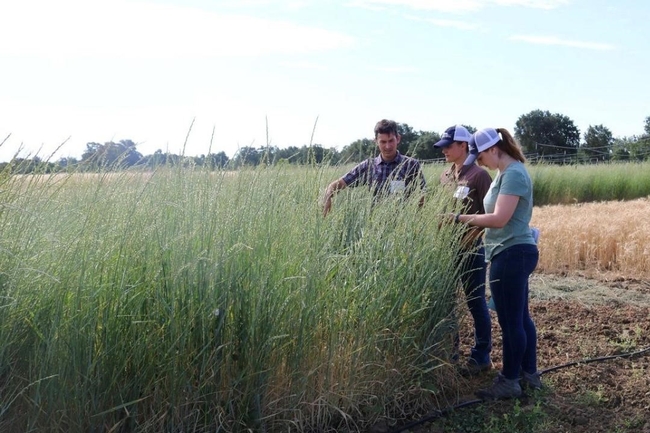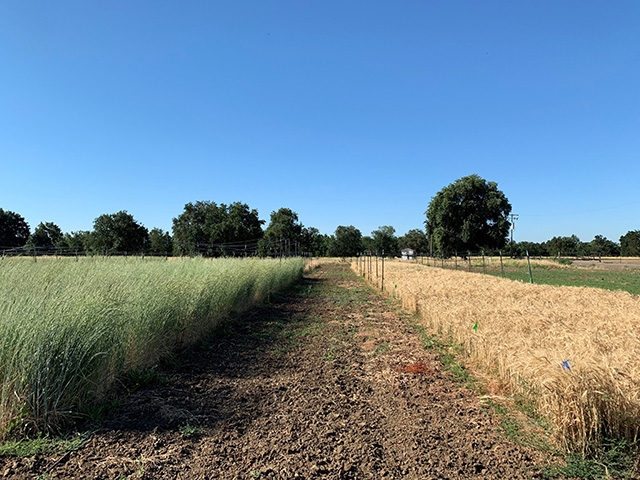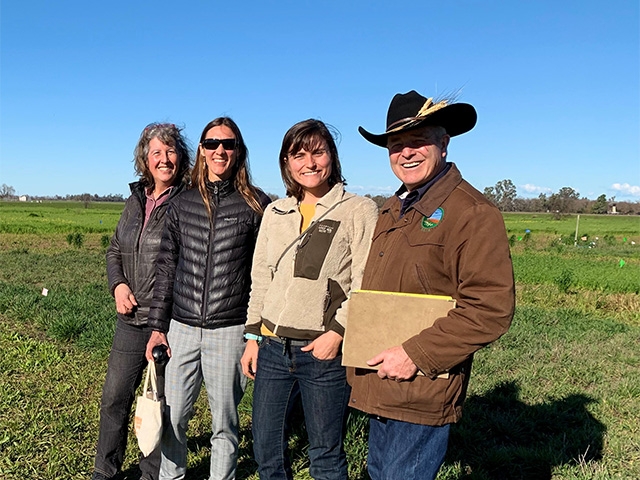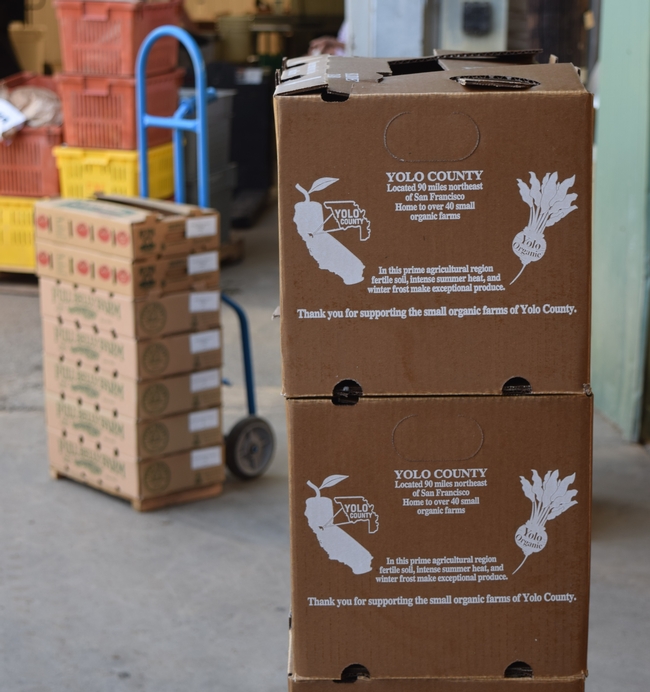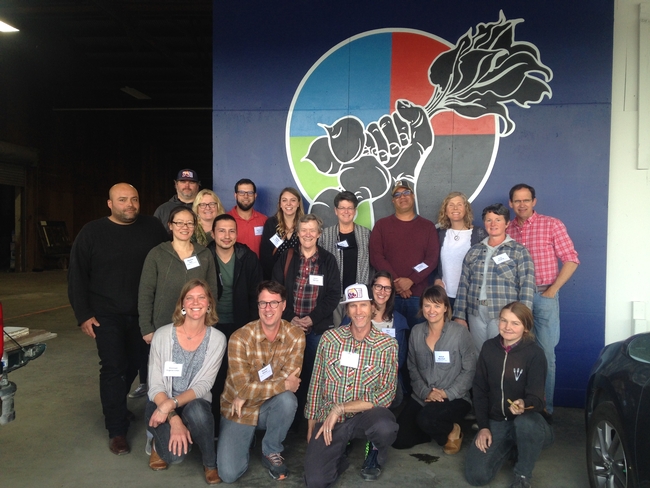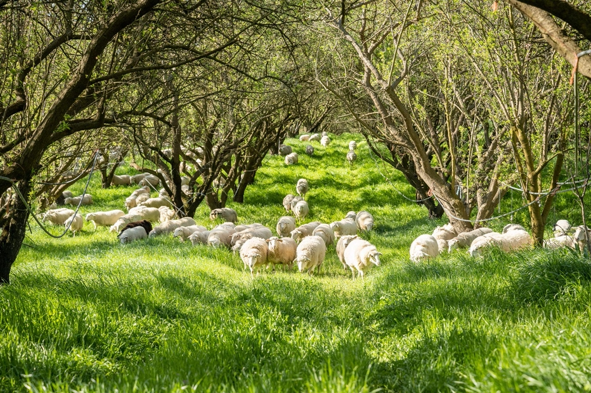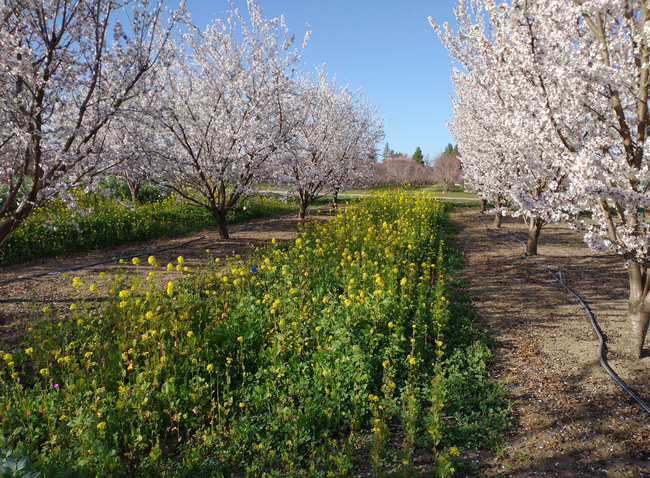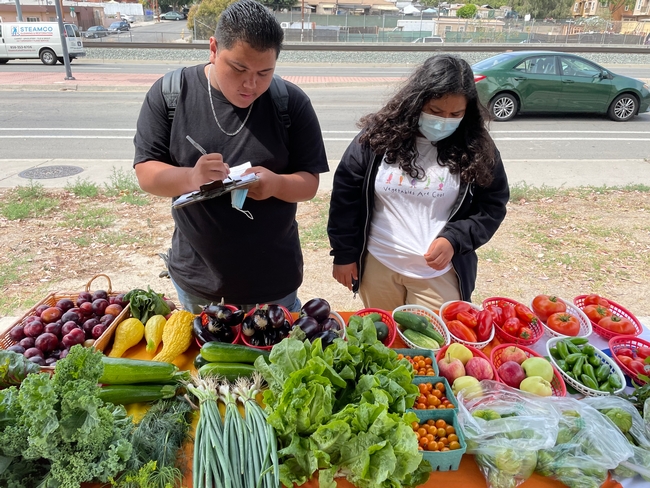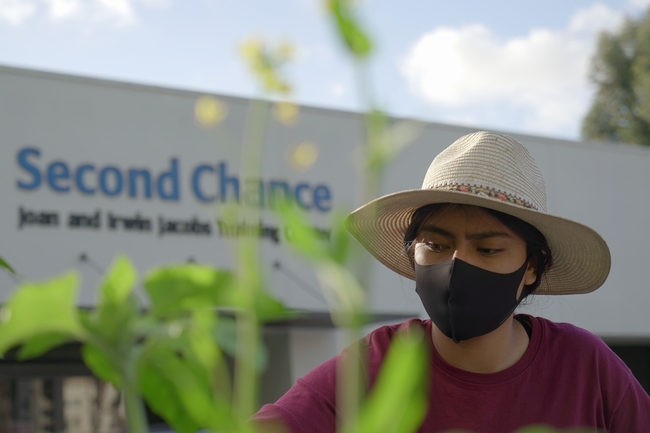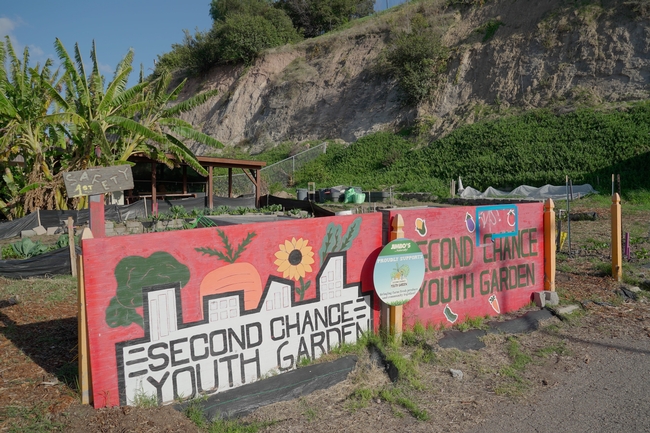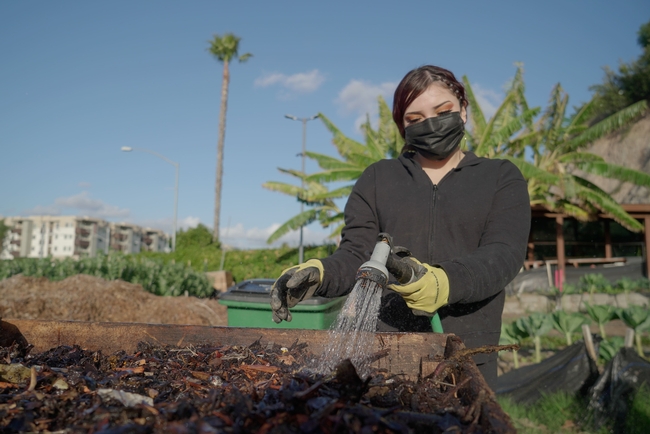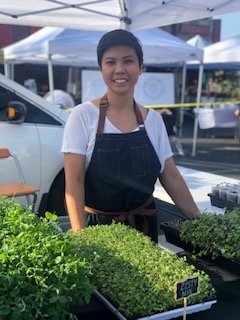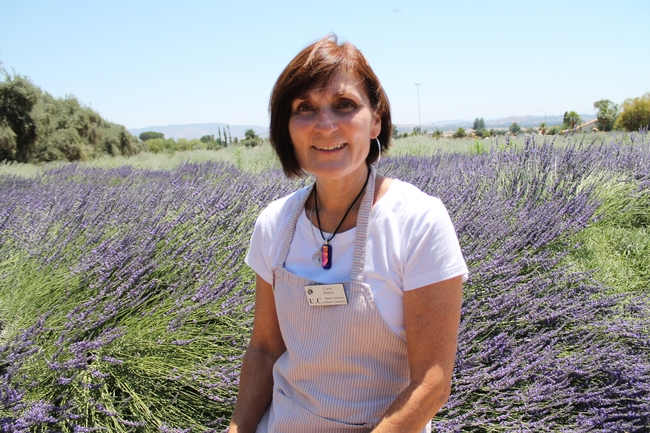Posts Tagged: Sustainable You!
No-till annual wheat better for soil health in California’s climate
One more reason to adopt sustainable cultivation
California wheat farmers could both maintain their yields and improve soil health by growing annual wheat without tilling the soil year after year.
This could be one more encouragement to farmers to adopt a sustainable practice commonly called conservation tillage, no-till or minimum-till cultivation, impacting how we grow a grain that supplies about 20 percent of the calories and protein for people around the world.
A new study, by a team led by Mark Lundy, University of California Cooperative Extension specialist in UC Davis' Department of Plant Sciences, offers new insight for decades-long discussions around soil conservation, sustainable agriculture and climate-warming emissions related to growing our food. The study has been published in the journal Soil and Tillage Research. For the first time, researchers have shown that annual wheat that is not tilled each year is better for stashing carbon in the soil than perennial wheatgrass, while still yielding more crop in Central California.
Previous studies have looked at annual wheat that is tilled each year, annual wheat that is not tilled, and a cousin species, perennial intermediate wheatgrass (trademarked Kernza), which also is not tilled. But until now, no one has looked at all of the benefits and trade-offs together. Most importantly, “no one has ever controlled for tillage,” Lundy said. “And, no one has compared annual wheat to perennial intermediate wheatgrass over multiple years in a Mediterranean climate, which is what we have in California.”
This study also is unique because it delves into the deeper question of what is going on in the soil that drives the different results for carbon there. Soil carbon reflects various processes linked to plant activity and soil health. Measuring the different forms of soil carbon may also signal whether a farming system is accumulating carbon in the soil over time – a plus for reducing climate-warming gases in the atmosphere.
“Measuring soil carbon is complex and nuanced,” said Kalyn Taylor, the lead author on the paper. “We started this experiment because we wanted to know whether and how plant activity and tilling or not tilling would affect the carbon story belowground in California's climate.”
“When we started this study, we thought the crop being perennial or annual would drive the differences in carbon storage in the soil,” Lundy added. Specifically, they had expected perennial wheatgrass would lead to more carbon in the soil because of its deeper, better-established root system. “But that's not what we found,” he went on. “What we found was, it was the lack of tillage, plus the level of productivity of common annual wheat, that made the difference in soil carbon here in California.”
Soil carbon in annual vs. perennial grain
In 2017, Lundy, then-graduate-student Taylor, UC Davis Professor Emeritus Kate Scow and others on the team started measuring different forms of soil carbon in test plots at Russell Ranch, west of campus. Plots were planted with annual wheat that was tilled each spring, annual wheat that was not tilled and perennial intermediate wheatgrass (Kernza) that also was not tilled.
Each year, the researchers measured the carbon present in the soil, the amount of soil organisms (which have carbon in their bodies) and the amount of material the plants created.
At the end of three growing seasons, they found that land planted with no-till, common, annual wheat had the highest amount of soil organisms, measured as biomass, of the three treatments.
The researchers also found soil carbon is more likely to remain stable in the no-till, annual plots, compared to both tilled wheat and wheatgrass.
In addition, the no-till, annual wheat produced plant material more consistently than the perennial wheatgrass across the three years, which saw variation in rainfall.
“Overall, annual wheat grown without soil disturbance or tillage had both higher productivity and higher potential for storing carbon in the topsoil than perennial wheatgrass in our Mediterranean climate,” Lundy said.
Related research
“No-till annual wheat increases plant productivity, soil microbial biomass, and soil carbon stabilization relative to intermediate wheatgrass in a Mediterranean climate,” is online now and will be published in the January 2024 edition of Soil and Tillage Research.
The team also found that tilled annual wheat vs. Kernza stores total carbon at different depths in the soil profile and hosts distinct soil fungal communities, primarily in the root zone and topsoil: Taylor, K., Samaddar, S., Schmidt, R., Lundy, M. and Scow, K., 2023. Soil carbon storage and compositional responses of soil microbial communities under perennial grain IWG vs. annual wheat. Soil Biology and Biochemistry, p.109111.
Previous work comparing the perennial grain known as intermediate wheatgrass (trademarked Kernza) to annual wheat had not distinguished the extent to which soil health benefits are a function of the perennial nature of the crop. Read the story here.
This story was originally published on the UC Davis News site.
Winter season: A time for food safety systems re-evaluation and education for food hubs
The holiday meal season is often a busy time for food hubs – entities that handle the aggregation, distribution and/or marketing of source-identified regional food – as restaurants, retailers and consumers fill their tables and shelves with an abundance of fresh, local products. However, the subsequent winter months can provide a valuable time for reflection and re-evaluation of a food hub's systems and processes. In this spirit, it may be helpful to remind people working at food hubs that University of California Sustainable Agriculture Research and Education Program (UC SAREP) offers a suite of food-safety resources – in English and in Spanish – on its website.
- A step-by-step guide for food hubs on how to pursue a third-party food safety audit with guidance on how to navigate buyers' questions.
- Two sample food-safety plans intended as a starting point to be adapted to a food hub's specific operations and practices.
- Example standard operating procedure, or SOP, documents related to 11 common tasks carried out by food hubs.
“We hope these resources can play a role in helping food hubs to adopt best practices and control risks related to food safety,” says Gwenael Engelskirchen, sustainable food and farming coordinator with UC SAREP, who led the development of these educational tools.
According to the Centers for Disease Control and Prevention, approximately, 1 in 6 Americans (or 48 million people) gets sick and 3,000 die of foodborne diseases annually. In 2011, to help prevent the occurrence of foodborne illness, the federal government enacted the Food Safety Modernization Act (FSMA), designed to outline actions to be taken at various points along the supply chain for both human and animal food.
UC SAREP's Food Safety Resources for Food Hubs are intended to help food hubs navigate these food-safety regulations and accompanying best practices. Resources are also available in Spanish at Recursos de seguridad alimentaria para los centros de distribución de alimentos.
Food safety certification guide
Some buyers verify a supplier's food safety program by requiring an audit performed by a third-party certification body or auditing company. This Guide to Food Safety Certification offers key considerations before deciding to pursue a food safety audit and helps users navigate the food safety certification process.
Food safety plan
Food hubs that meet the criteria for full compliance with FSMA's Preventive Controls for Human Food Rule are required to have a food-safety plan in place. And for all food hubs, having a shared document describing the facility's operations and how potential risks of food contamination are managed is a good idea. Two sample food safety plans, inspired by the operations of food hubs in California, provide a starting point and can be adapted to a hub's own operations.
Standard operating procedures
Standard operating procedures provide detailed step-by-step instructions for how to carry out operational tasks within a food facility. The standard operating procedure samples cover common topics such as handwashing, facility cleaning and more, and are intended to be adapted to a food hub's specific operations and practices.
Jacob Weiss from Spork Food Hub in Davis said, “the templates were a great starting place for us to build the framework of our food safety plan. It helped us figure out what we needed to (and didn't) need to include. I think the SOPs are also really useful because they are broad enough to get you started but flexible enough to add the specific practices of your business or hub.”
For additional information, visit UC SAREP's webpages on Food Safety Resources for Food Hubs or Recursos de seguridad alimentaria para los centros de distribución de alimentos.
These resources and tools were developed in collaboration with various project partners, including Department of Food Science and Technology at UC Davis, Department of Population Health and Reproduction at UC Davis School of Veterinary Medicine, Center for Precision Medicine and Data Science at UC Davis Health, and Community Alliance with Family Farmers.
Growers invited to see benefits of cover crops in orchards, vineyards
Searchable database of growers experienced in growing cover crops launched
Growers are invited to tour orchards and vineyards and hear from other growers about their experiences with cover crops.
UC Sustainable Agriculture Research and Education Program, UC Cooperative Extension, the Napa Resource Conservation District, and the Community Alliance with Family Farmers have created a searchable database of orchard and vineyard growers experienced in growing cover crops that will help other growers bring the benefits of the practice to their operations.
“The tours are part of a project for which we recently unveiled new tools for orchard and vineyard growers to learn about cover cropping from experienced growers,” said Sonja Brodt, associate director of the UC Sustainable Agriculture Research and Education Program.
The database describes cover cropping strategies, details of field practices, benefits and challenges experienced by cover crop growers in orchards and vineyards in the southern Sacramento Valley (including the Capay Valley) and the North Coast viticulture region. The cover crop grower database is available at https://sarep.ucdavis.edu/covercropsdb.
Feb. 8, 1-5 p.m., Capay Valley tour:
The tour will visit three organic farms in the Capay Valley that are integrating cover crops and grazing in their orchard and vineyard systems. Topics of discussion will include:
- Strategies for integrating cover crops into orchards and vineyards
- Impacts of cover cropping and grazing on soil health
- Funding and information resources for growing cover crops
Speakers will include:
- Rory Crowley, Director of Habitat Programs, Project Apis m.
- Amélie Gaudin, Associate Professor, Department of Plant Sciences, UC Davis, Endowed Chair in Agroecology
- Hope Zabronsky, Climate-Smart Agriculture Program lead, UC Agriculture and Natural Resources
To register for the Feb. 8 tour, visit https://sarep.ucdavis.edu/events/grazing-cover-crops-orchards-and-vineyards-capay-valley-tour.
March 8, 1-4 p.m., Arbuckle area tour:
The tour will visit two conventional farms in the Arbuckle area that are integrating cover crops into their orchard and vineyard systems.
Topics of discussion will include:
- Strategies for integrating cover crops into orchards and vineyards
- Impacts of cover cropping on soil and water balance
- Frost risk protection and prevention
- Funding resources for growing cover crops
Speakers will include:
- Rory Crowley, Director of Habitat Programs, Project Apis m.
- Kosana Suvocarev, UC Cooperative Extension Specialist in Biometeorology, UC Davis Department of Land, Air, and Water Resources
- Hope Zabronsky, Climate-Smart Agriculture Program lead, UC Agriculture and Natural Resources
To register for the March 8 tour, visit https://sarep.ucdavis.edu/events/cover-cropping-conventional-orchards-and-vineyards-arbuckle-area-tour
Youth-run garden provides 10,000 pounds of produce for San Diego families
UC SAREP's Sustainable Agriculture and Food Systems grant helps support Second Chance garden
Fifteen-year-old Xavier knows the anger within him will never leave. “I can't ever get rid of it,” he said.
“I've always wanted to just fight for no reason; I just had an anger issue, losing my temper quick with people,” added Xavier, a ninth-grader in San Diego County. “I have high expectations of myself.”
Xavier is working to keep his emotions under control, and he has found a sense of calm through his volunteer work. He was an intern – and then a peer supervisor – in the youth-run garden of Second Chance, a San Diego-based organization that works to break the cycles of poverty and incarceration by providing housing and job training to adults and young people.
Operating their garden as a small farm business, youth in the program, ages 14 to 21, offer produce to the community through their farm stand and a CSA (Community Supported Agriculture) model.
“The project incorporates a ‘farm to fork' approach in which youth not only experience how to grow food, but how to cook and eat healthfully,” said Gail Feenstra, director of the University of California Sustainable Agriculture Research and Education Program, which has a grant program that funds research and education projects – such as the youth garden – supporting sustainable food systems.
“Second Chance works primarily with youth in communities of color, providing them with training and also helping them develop confidence in themselves,” Feenstra said.
Filling a critical need for fresh produce
Caelli Wright, program manager of the Second Chance youth garden, said that grant funds from SAREP – a program of UC Agriculture and Natural Resources – have been used to purchase the supplies needed to sustain the program. The garden has filled a critical need for produce during the COVID-19 pandemic.
“After the pandemic hit, we recognized the increased need for fresh food in our neighborhoods,” Wright said. “That need was already there – southeast San Diego is considered a ‘food swamp' or ‘food apartheid', if you will – and with the onset of COVID, that need just escalated with unemployment and complications in our food production systems.”
Through a partnership with UC San Diego Center for Community Health and Encanto Elementary School (located down the block from the garden), donations enabled the program to give its CSA shares to about 25 families at Encanto. Over the course of the pandemic, the youth have grown 10,000 pounds of produce to donate.
At the same time, the program helps the young participants grow. For Xavier, being outdoors with peers empowered him to develop positive relationships. Previously, as a student in a charter school program, he was not accustomed to interacting with people and groups. Volunteering in the youth garden has given him a fresh perspective and understanding of others.
“Learning to be patient with people and [to] accept sometimes that if I don't know something, I need to ask about it, because I used to be so in my ego that I thought I knew everything,” Xavier explained. “But I don't know everything – I just learned to accept some things…that's just being part of life. And that's something that the garden has helped me with, personally.”
Opportunities for personal, social growth
Developing – and redeveloping – social skills are especially important for students, as they return from the disconnections associated with remote learning.
“Right now, with a lot of students facing the aftermath of COVID and being restricted to learning at home and not getting as much social interaction in their daily lives, it's led to a lot of challenges, mental health-wise, and social and emotional learning-wise,” Wright said. “The garden program provides that opportunity that some youth have been missing out on.”
In southeast San Diego, such crucial opportunities for personal growth and career exploration are harder to come by, and Second Chance started the garden in 2012 to give youth a unique work experience and valuable skills. About 400 young people have participated in the program.
“The youth that we serve are coming from low-income neighborhoods that are underserved with resources,” Wright said. “They just are not exposed to the same opportunities [as those in higher-income areas] to build skills or be ready for the workforce or to reach higher education – so that's where our program comes in and helps deliver those needed services.”
Xavier, who originally came to the garden because he heard that landscaping could be a lucrative career, recently finished his second stint as a peer supervisor in the youth garden. With his new skills, he and his cousin are looking to start a business of their own, cutting grass and doing yardwork in their community.
And, late last month, Xavier transferred to a more traditional high school environment.
“Being in a charter school after two, three years,” he said, “I've realized I miss being around more people.”
Small-scale growers meet virtually to discuss organic agriculture
Over 150 current and prospective organic growers gleaned practical information shared by UC Agriculture and Natural Resources experts at the “Introduction to Small-Scale Organic Agriculture” workshop held virtually on Dec. 15, 2020. While most attendees were from inland San Bernardino, Riverside, Los Angeles and Orange counties, a handful were
from other continents, including growers from Bangladesh and Sri Lanka who stayed connected into the wee hours of their morning.“I attended this workshop and it was very helpful to hear different aspects of organic farming from experienced people,” one attendee from Sri Lanka said in an email.
UC Sustainable Agriculture Research and Education Program (SAREP) Director Gail Feenstra and Deputy Director Sonja Brodt kicked off the day with a presentation on program goals and resources. SAREP supports the goals of growers by developing more sustainable agricultural practices and effective regional food systems. They described a new online self-directed training program for organic specialty crop farmers in California and those in transition at https://ofrf.org/beginning-farmer-training-program. They also discussed marketing and business management.
Houston Wilson, director of UC ANR's new Organic Agriculture Institute, provided an overview of the program and pointed out that organic farming is expanding throughout California and includes more than 360 commodities. UC ANR will continue to take a lead role in developing and extending research and extension to this important sector, he said.
UC Cooperative Extension sustainable food systems advisor Rachel Surls discussed legal basics such as permits, licenses and regulations. UC Cooperative Extension organic agriculture specialist Joji Muramoto talked about the importance of soil health, a very popular and important topic. Other UC Cooperative Extension presenters covered nitrogen management (small farms advisor Margaret Lloyd), irrigation management (irrigation specialist Amir Haghverdi), integrated pest management (IPM advisor Cheryl Wilen), and plant diseases (plant pathology specialist Alex Putman).
“Thank you for the great workshop and resource links you provided for workshop materials and beyond! I have already downloaded and started to incorporate information from a few of the UC ANR pest management guidelines and legal and marketing links,” wrote an attendee from Chino. “Tips from peers are always great, too.”
During the afternoon portion of the workshop, five California organic farmers shared tips from their experiences. Carol Hamre (123 Farm, Cherry Valley) spoke about her trials and successes regarding vertebrate pest control and drip irrigation. Grace Legaspi (Tiny Leaf Micro Farm, Temescal Valley) talked about the art and science of growing microgreens. Lisa Wright (RD Flavorfull Farm, Riverside) discussed the importance of planting the right varieties in the right seasons. Arthur Levine (Huerta del Valle, Ontario) stressed the importance of collaboration and working synergistically as a team, and the importance of inclusiveness in all practices. Richard Zapien (‘R Farm, UC Riverside) shared inspiring stories and opportunities regarding the popular and successful UC Riverside community garden he manages.
“I am very glad to attend this workshop as a Bangladeshi,” wrote a grateful attendee from half way around the world. “Really, I have learned many things about organic farming in this workshop. I am working in the Tree nuts sector in Bangladesh but I have only cashew nuts plantation and processing factory…. I want to make an organic farm on 25 acres of land to cultivate vegetables, fruits, livestock, and fishing. Thanks again.”
Following the workshop, an extensive list of UCANR and external resources on topics covered during the workshop was provided to attendees https://ucanr.edu/sites/smallscalefarming/RESOURCES_/.
“I wanted to thank you for such a great webinar,” replied another Southern California participant. “I am a farm business advisor with the non-profit Kitchen Table Advisors and I learned a lot myself. Thank you for providing this list of resources. I look forward to the webinar recordings and slides, which I hope to be able to share with some of my farmer clients.”
The efforts of our co-sponsors also led to the overall success of the workshop. Inland Empire Resource Conservation District (IERCD) Manager Mandy Parkes, co-moderator, discussed district irrigation and soil testing resources and handed out gift certificates throughout the day. Evelyn Hurtado from IERCD volunteered to translate the workshop recordings into Spanish and Maggie O'Neill shared membership information and resources from the San Bernardino County Farm Bureau. Other co-sponsors included the Riverside County and Orange County Farm Bureaus. The California Certified Organic Foundation promoted the workshop and heightened awareness of UC ANR's programs and activities in the field of organic agriculture.
The PowerPoint presentations and recordings in English will be posted on the UCCE San Bernardino County website: https://ucanr.edu/sites/smallscalefarming/ by Feb. 15, 2021, and the Spanish translations later this winter. Next year, if conditions allow, actual farm visits will be included.


